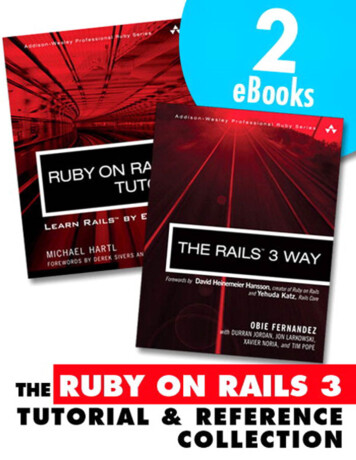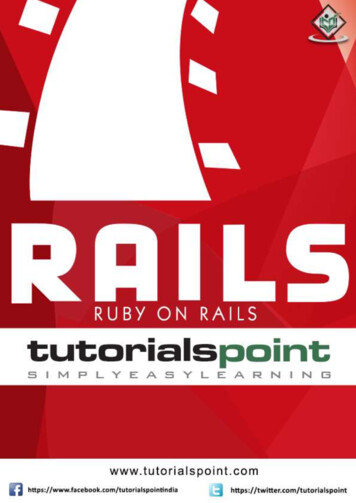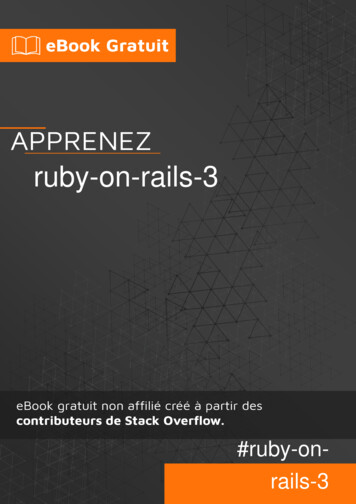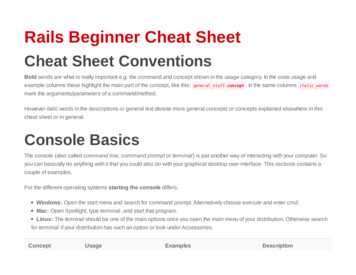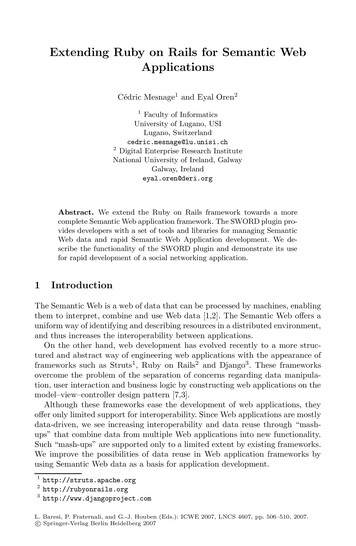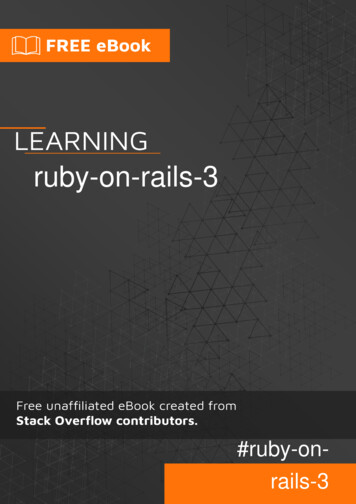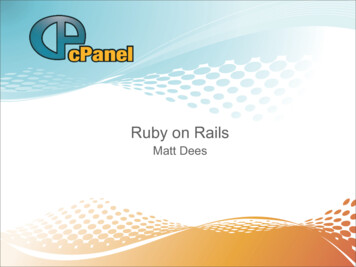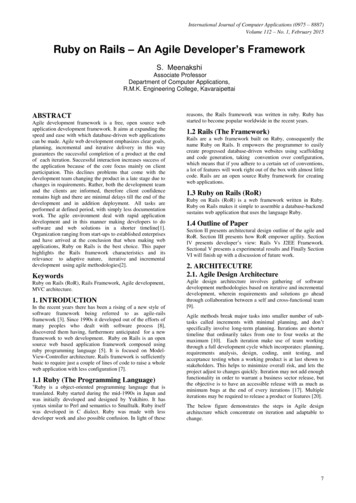
Transcription
International Journal of Computer Applications (0975 – 8887)Volume 112 – No. 1, February 2015Ruby on Rails – An Agile Developer’s FrameworkS. MeenakshiAssociate ProfessorDepartment of Computer Applications,R.M.K. Engineering College, KavaraipettaiABSTRACTAgile development framework is a free, open source webapplication development framework. It aims at expanding thespeed and ease with which database-driven web applicationscan be made. Agile web development emphasizes clear goals,planning, incremental and iterative delivery in this wayguarantees the successful completion of a product at the endof each iteration. Successful interaction increases success ofthe application because of the core focus mainly on clientparticipation. This declines problems that come with thedevelopment team changing the product in a late stage due tochanges in requirements. Rather, both the development teamand the clients are informed, therefore client confidenceremains high and there are minimal delays till the end of thedevelopment and in addition deployment. All tasks areperformed at defined period, with simply less documentationwork. The agile environment deal with rapid applicationdevelopment and in this manner making developers to dosoftware and web solutions in a shorter timeline[1].Organization ranging from start-ups to established enterprisesand have arrived at the conclusion that when making webapplications, Ruby on Rails is the best choice. This paperhighlights the Rails framework characteristics and itsrelevance to adaptive nature, iterative and incrementaldevelopment using agile methodologies[2].KeywordsRuby on Rails (RoR), Rails Framework, Agile development,MVC architecture.1. INTRODUCTIONIn the recent years there has been a rising of a new style ofsoftware framework being referred to as agile-railsframework [3]. Since 1990s it developed out of the efforts ofmany peoples who dealt with software process [8],discovered them having, furthermore anticipated for a newframework to web development. Ruby on Rails is an opensource web based application framework composed usingruby programming language [5]. It is focused on ModelView-Controller architecture. Rails framework is sufficientlybasic to require just a couple of lines of code to raise a wholeweb application with less configuration [7].1.1 Ruby (The Programming Language)"Ruby is a object-oriented programming language that istranslated. Ruby started during the mid-1990s in Japan andwas initially developed and designed by Yukihiro. It hassyntax similar to Perl and semantics to Smalltalk. Ruby itselfwas developed in C dialect. Ruby was made with lessdeveloper work and also possible confusion. In light of thesereasons, the Rails framework was written in ruby. Ruby hasstarted to become popular worldwide in the recent years.1.2 Rails (The Framework)Rails are a web framework built on Ruby, consequently thename Ruby on Rails. It empowers the programmer to easilycreate progressed database-driven websites using scaffoldingand code generation, taking convention over configuration,which means that if you adhere to a certain set of conventions,a lot of features will work right out of the box with almost littlecode. Rails are an open source Ruby framework for creatingweb applications.1.3 Ruby on Rails (RoR)Ruby on Rails (RoR) is a web framework written in Ruby.Ruby on Rails makes it simple to assemble a database-backendsustains web application that uses the language Ruby.1.4 Outline of PaperSection II presents architectural design outline of the agile andRoR. Section III presents how RoR empower agility. SectionIV presents developer‟s view: Rails Vs J2EE Framework.Sectional V presents a experimental results and Finally SectionVI will finish up with a discussion of future work.2. ARCHITECUTRE2.1. Agile Design ArchitectureAgile design architecture involves gathering of softwaredevelopment methodologies based on iterative and incrementaldevelopment, wherein requirements and solutions go aheadthrough collaboration between a self and cross-functional team[9].Agile methods break major tasks into smaller number of subtasks called increments with minimal planning, and don‟tspecifically involve long-term planning. Iterations are shortertimeline that ordinarily takes from one to four weeks at themaximum [10]. Each iteration make use of team workingthrough a full development cycle which incorporates: planning,requirements analysis, design, coding, unit testing, andacceptance testing when a working product is at last shown tostakeholders. This helps to minimize overall risk, and lets theproject adjust to changes quickly. Iteration may not add enoughfunctionality in order to warrant a business sector release, butthe objective is to have an accessible release with as much asminimum bugs at the end of every iterations [17]. Multipleiterations may be required to release a product or features [20].The below figure demonstrates the steps in Agile designarchitecture which concentrate on iteration and adaptable tochange.7
International Journal of Computer Applications (0975 – 8887)Volume 112 – No. 1, February 2015releaseproductsProductownersDefineSystemV V2.3 The Components of Rails1 2ClientsPlanreleasesiterateArchitecture of Rails framework is illustrated in Figure 3. Railsarchitecture comprises of two noteworthy elements whichincorporates Active Record and Action Pack.FinalPlanreleasesAccept?Track & AdjustCentralizedWork productsFigure 1. Agile Design ArchitectureAction Record is an Object Relational Mapping (ORM) layerwhich handles the Model element of the MVC application.This layer covers the data table rows as model objects to therest of the application.Action Pack handles the view and controller elements of theMVC application. Action Pack comprises of two parts viz.Action View and Action Controller which handle View andController of MVC application individually.2.2. Rails Design ArchitectureEach of the architectural elements in the picture above isdetailed below:Rails are focused on a programming pattern called MVC,which remains for Model-View-Controller. The Goal of Raildesign outline is to discrete organization of data (model)from UI & presentation (view) by introducing controller.(a) User component – Rails web application is accessed bybrowsers using different protocol interfaces such as HTTP,FTP or expended as a web services using SOAP.The MVC ArchitectureOne of the important feature of Ruby on Rails is it depend onModel-View-Controller architecture (MVC)[22]. The mainadvantage of MVC is to have the detachment of Businesslogic from client-user interface. Other advantage incorporatesease of keeping code, DRY and making it clear wheredistinctive sorts of code belong for less demanding upkeep.Controllerinteract withmodel andinvoke viewCONTROLLER.rb (Ruby) codeBrowsersend request(b) Web Server – The developed Rails application dwells on aWeb Server, which handles request from the client-usercomponent and advances them to the Dispatcher.(c) Dispatcher – Dispatcher invokes proper controller focusedon the current user request.(d)Controller –Controller processes the user request andinvokes proper action.The action works together with appropriate model objects andprepares the response. In the event that the request was fromthe browser, the response will be rendered through ActionView Component else a suitable response is relayed by eitherthe Action Web services or the Action Mailer ODELSQL Table Ruby ClassAction WebServicesBrowserClientdisplaysAction ntrollerDispatcherWeb serverredirectsView renders nextbrowser screenFigure 2. MVC ArchitectureModel: Model stores the information (data) about each tableof database. If there should arise an occurrence of Rails, dosome primary validation of data before putting into databaseand one table relate to one model.View: View, for the most part the interface of theapplication. If there should be an occurrence of Rails, Viewsare often HTML pages with some inserted ruby code. Viewshandle the job of giving the data to web browser.Controller: Controllers gives the “glue” in the middlemodels and views. In Rails, Controller fundamentallyhandles the incoming request from the web browserinterrogating the models for data and passing that data on tothe views for presentation.queriesActive recordCRUDrespondsqueriesDatabasedata//errorFigure 3. Architecture Model for Ruby on Rails (RoR) WebApplication Implementation3. HOW DOES RUBY ON RAILS ENABLEAGILE DEVELOPMENTWhat makes rails agility which thus infers how Ruby on Railsempowers agile development? In this section might elaboratethe characteristics of Rails framework that make it mostappropriate for agile methodologies.MVC architecture - which permits web professionals topartition business logic, user presentation and control featuresand encourage the process of web development.8
International Journal of Computer Applications (0975 – 8887)Volume 112 – No. 1, February 2015CRUD (Create, Read, Update, Delete) - In the heart of theRails routing engine lies CRUD, or Create, Read, Update,Delete, which originates from a notion that all web pages arecomprised of these four actions. For example, can make aproduct, view, or read a client-user, edit, or update acategory, and delete an order.If follow this pattern, will accomplish a great deal of workdone. For example, all it takes to make all of these actions fora product is to make the routing engine that have an entitycalled product, and it will wire up all the routing logic thatties the request to the matching controller.DRY – “Don‟t Repeat Yourself” – suggests that writing thesame code over and over again is a terrible thing.Convention Over Configuration – implies that Rails makespresumptions about what need to do and how are going todo it, rather than letting to change every little thing throughinterminable configuration files.REST (pattern) - is the best pattern for web applications forsorting the application around resources and standard HTTPis the fastest approach to go.Scaffolding - often make transitory code in the early phasesof development to help get an application up rapidly andperceive how major components work together. Railsautomatically make a great part of the needed scaffolding.Portable programming skills – Team managers will admirethe way that Rails minimizes configuration and encouragesstandardization. This empowers the programming skills moreportable.Rapid feedback loop – In Rails yet get almost-instantfeedback as with code. Thus consequences of the progressmade can be immediately seen improving the overall clientcustomer experience empowering changes made instantly aswell.A great number of software development companies strive tomake the procedure of web application development lesstedious and more flexible; hence, such organizations and itsweb specialists take advantage of Ruby on Rails technology,which allows them to utilize the principles of agiledevelopment.4. DEVELOPER’S VIEW: RAILSVERSUS J2EE WEB FRAMEWORKConsidered as agile web frameworks and Rails won overJava Web Framework as well. Unfortunately, otherframeworks are not in this comparison. In perspective withDevelopers, the ruby has the following advantages andcomparison with J2EE framework:4.1 Ruby AdvantagesContrasted to Java, Ruby is a much more adaptable language.Map and inject methods permit the code to be composed in acompact and readable way compared to the conventional wayof wrapping the code inside loops through passing in Rubycode blocks.Strings in Ruby are mutable and provide a extremelycomprehensive API. More compact syntax and some moreadaptable classes allows numerous tasks to be performedmuch more rapidly in Ruby than in Java. Having to deal withless code also prompts to a much smaller, more viablecodebase.A little, better maintained codebase leads to a more completetest scope and less wasted time in refactoring, all prompting toa much more productive and enjoyable software development.4.2 Rails versus J2EE Web FrameworkThe Ruby on Rails is most likely the most comparableframework to a usual J2EE stack. Many of the libraries foundin J2EE have a counterpart in one form or an alternate in Rails.Ruby counterparts are frequently less powerful and adaptable;however require less maintaining and less code from adeveloper to perform the same task.Rails is significantly more invested in tradition than inconfiguration. J2EE libraries like Hibernate and Spring arevery adaptable and configurable however accompanied anincreased cost in maintainability.Both Spring and Hibernate gives an extremely adaptablestructure through effortlessly replaceable modules. Hibernategives an experienced developer a great deal more control onhow the application flow will be processed.Spring offers a lot of different modules for completecustomization, giving quite a bit of common functionalities fora web application.Rails accompany a lot of handy and powerful generators thatmake it extremely easy to take after the set of conventions.Setting up a project quickly from scratch makes buildingRESTful applications in MVC architecture with Ruby on Railsis requests of extent faster than with its J2EE counterparts.Maintenance - Ruby counterparts are often less effective andadaptable, yet do also require less maintaining and less codefrom a developer to perform the same task.Standard Convention - Rails is significantly more resource intotradition than in configuration. Rails accompany a lot of handyand powerful generators that make it to a great degree simpleto follow the set of conventions.RESTful Application - Setting up a project rapidly fromscratch makes building RESTful applications in MVCarchitecture with Ruby on Rails is orders of magnitude quickerthan with its J2EE counterparts.5. EXPERIMENTAL RESULTS“Ruby on Rails is a breakthrough in lowering the barriers ofentry to programming. Powerful web applications thatformerly might have taken weeks or months to develop can beproduced in a matter of days.”-Tim O'Reilly, Founder of O'Reilly MediaIn this case study, created a support web log application usingRuby on Rails and Net Beans. The steps are given as follows:Step1: In Net beans, Start by creating a new project Ruby Ruby on Rails Application project Name-weblog.This will create all the files and dirs. needed by a standardproject including Controllers, models and viewsStep2: Select Controllers – look for db configuration whereusing MYSQL database by default database as weblogdevelopment. Hence by outside netbeans in MYSQLcommands line client - MYSQL create database weblogdevelopment;Step 3: Now ready to create a model, use generator to generatemodel9
International Journal of Computer Applications (0975 – 8887)Volume 112 – No. 1, February 2015Select weblog generate modelIn arguments – entry title: string content: textModel will be called entry – one entry for each for weblogentryAnd there will be two fields: title and contentJreader creates DB migrations scripts, this script will runto createthe table – that‟s the modelCan see the migration changed for the two columns tile andthe contentStep4:InMigrations Migrate 001 create entries.rbweblog DatabaseIf def is self.up – create the tableIf def self.down – if reverse the migration the table will bedropped.Step 5: Let‟s apply this migration now.Weblog Migrate Database To current versionOnce migrated now ready to create the fields and controlsfor creating progressed web applications writing very littlecode in comparison [16]. Recommend it for almost any kind ofapplication, and particularly for prototyping [19]. To have afirm conclusion that a blog can be created within a momentusing Ruby on Rails. Due to its straightforward nature andsimple to use features as well as the speed of projectcompletion,7. ACKNOWLEDGMENTWould like to thank the institution, referred to in this paperanonymously, without which this piece of research would nothave been possible. Also like to thank the many facultieswithin the Institution for their cooperation and support.Grateful to thank HOD-Computer Applications of theInstitution, for the constant support given by him, and thank theunknown referees for their helpful comments and suggestionsto improve this work.8. REFERENCES[1] Nerur S, Mahapatra R & Mangalraj G (2005), Challengesof migrating to agile methodologies Communication ofthe ACM, Vol. 48 No. 5, Pages 72-78 New York USA.[2] Martin Fowler “New Methodology” , http://martinfowler.com/ articles/ newMethodology.html Vol. 1 de 17(19/08/2010)Step 6: Use the generator to create scaffold for the model entry[3] Andrew Mcdonald, “Agile Web Engineering (AWE)Process: Perceptions Within A Fortune 500 FinancialServices Company” Journal Of Web Engineering, Vol. 4,No.4 (2005) 283-312.Step 7: At this point completed the application so as to run[4] http://en.wikipedia.org/wiki/Agile software development.needed to create an applicationWeblog RunIt has been switched to http://localhost:3000/entries andcreated anew oneStep 8: Listing Entries- Title – Content - New Entry click onStep 9: In Title – Hello world!In Content – This is my first entry. Yeah press create button.As of right now effectively created first weblog applicationusing Ruby on Rails and Netbeans in a moment.6. CONCLUSION AND FUTUREENHANCEMENTSRuby on Rails as an open source web applicationdevelopment framework focused around Ruby programminglanguage and used extensively by agile programmer teamshas been pretty popular for rapid web applicationdevelopment. Two interesting aspects of RoR stand out – the„convention over configuration‟ wherein programmersspecify the unusual configuration as well as „Don‟t RepeatYourself‟ wherein information used is unique and notduplicated.Rails are a perfect platform for Agile development practices.Keeping in view its agreement with the Agile Manifesto, it isnot difficult to foresee that Rails will be the future of Agiledevelopment[11]. As a fairly new web framework, Ruby onRails has not yet seen the prominence of a number of today‟scurrent standards such as Java or .NET basedframeworks[12]. This does not imply that Ruby on Rails isunequipped of handling real world applications, as it can andhas been taking care of wide range of dynamic web-supportprojects [15]. Ruby on Rails is a extraordinary framework[5] Osmar Zaine, “Report on Ruby on Rails”, CMPUT 410,November 16, 2007.[6] Bram Wiebe, Trevor Jones, Wanying Luo, HowardChung -group presentation, “Ruby on Rails”, OsmarZaine November 16 2007.[7] Qumer., & Sellers, An evaluation of the degree of agilityin six agile methods and its implacability for methodengineering. Information and Software Technology,(2008) 280-295.[8] Phalnikar, Deshpand, &Joshi, Applying Agile Principlesfor Distributed Software Development - InternationalConference on Advances in Computing andCommunications 01/2009; DOI:10.1109/ICACC.2009.93ISBN: 978-0-7695-3516-6.[9] Judy, Simon & Schuster, Agile principles and ethicalconduct. Proceedings of the 42nd Hawaii InternationalConference on System Sciences-2009.[10] Malik Hneif, Siew Hock Ow, “Review Of AgileMethodologies In Software Development”, InternationalJournal of Research and Reviews in Applied SciencesISSN: 2076-734X, EISSN: 2076-7366 Volume 1, Issue1(October 2009).[11] Asad Awan, “Agile Web Development with Rails – AnOverview”, Research article Friday 16. of January 2009.[12] Sudipto Das, Vinod Kone “Ruby under Scanner:Comparison with Java” University of California, SantaBarbara 2010[13] João M. Fernandes and Mauro Almeida, “A Technique toClassify and Compare Agile Methods” (Eds.): XP 2010,10
International Journal of Computer Applications (0975 – 8887)Volume 112 – No. 1, February 2015LNBIP 48, pp. 385–386, 2010. Springer-Verlag BerlinHeidelberg.[14] Dwayne Read, “Going Agile- A Case Study”, 2010[15] Aspire Systems, “Ruby on Rais-Building DynamicWeb Products Faster”, 2011.[16] Feng Ji and Sedano T, “Comparing ExtremeProgramming and Waterfall Project Results” CarnegieMellon University June 2011.[17] Nystrom Anna, Agile Solo, “Defining and Evaluating anAgile Software Development Process for a singleSoftware Developer” Chalmers University ofTechnology June 2011.[18] S.Balaji, Dr.M.Sundararajan, Murugaiyan, “WateerfallVs V-Model Vs Agile: A Comparative Study OnSDLC”, International Journal of InformationTechnology and Business Management 29th June 2012.Vol.2 No. 1 2012.[19] Brian Wernham, “Agile Project Management forGovernment Case study: The Success of the FBISentinel Project” , Talk given at the Agile BusinessConference (ABC2012) 10th October 2012 held at theInmarsat Centre, London[20] Mr. D. T. T. Vijaya Kumar & Ms. M. Sowmyavani,“Agile Software Development: A Case Study of WebApplication” , Global Journal of Computer Science andIJCATM : www.ijcaonline.orgTechnology Software and Data Enbgineering, Volume 12Issue 14 Version 1.0 Year 2012.[21] Bram Wiebe, Trevor Jones, Wanying Luo, HowardChung, Kaushal Pathak Anju Saha, Review of AgileSoftware Development Methodologies, InternationalJournal of Advanced Research in Computer Science andSoftware Engineering, Volume 3, Issue 2, February 2013ISSN: 2277 128.[22] Sam Ruby, Dave Thomas, David Heinemeier Hansson,“Agile Web Development with Rails”, Third Edition,2013.9. AUTHOR’S PROFILES. Meenakshi received Master of Computer Applicationsunder Madras University, Chennai and Master of Philosophyfrom Periyar University, Erode. Currently she is working as anAssociate Professor in the Department of ComputerApplications, R.M.K. Engineering College, Kavaraipettai andpursuing Ph.D. programme in the Department of ComputerScience, Mother Teresa Women‟s University, Kodaikanal.Prior to join in RMKEC she was working with web since 2003.She has been an author for many web enabled projects. Shealso presented many papers in National and Internationalconferences and Journals. She has published a Book on WebGraphics, Scitech Publications, Chennai. He is a life memberof ISTE (Indian Society for Technical Education) and CSI(Computer Society of India.11
development using agile methodologies[2]. Keywords Ruby on Rails (RoR), Rails Framework, Agile development, MVC architecture. 1. INTRODUCTION In the recent years there has been a rising of a new style of software framework being referred to as agile-rails framework [3]. Since 1990s it developed out of the efforts of
